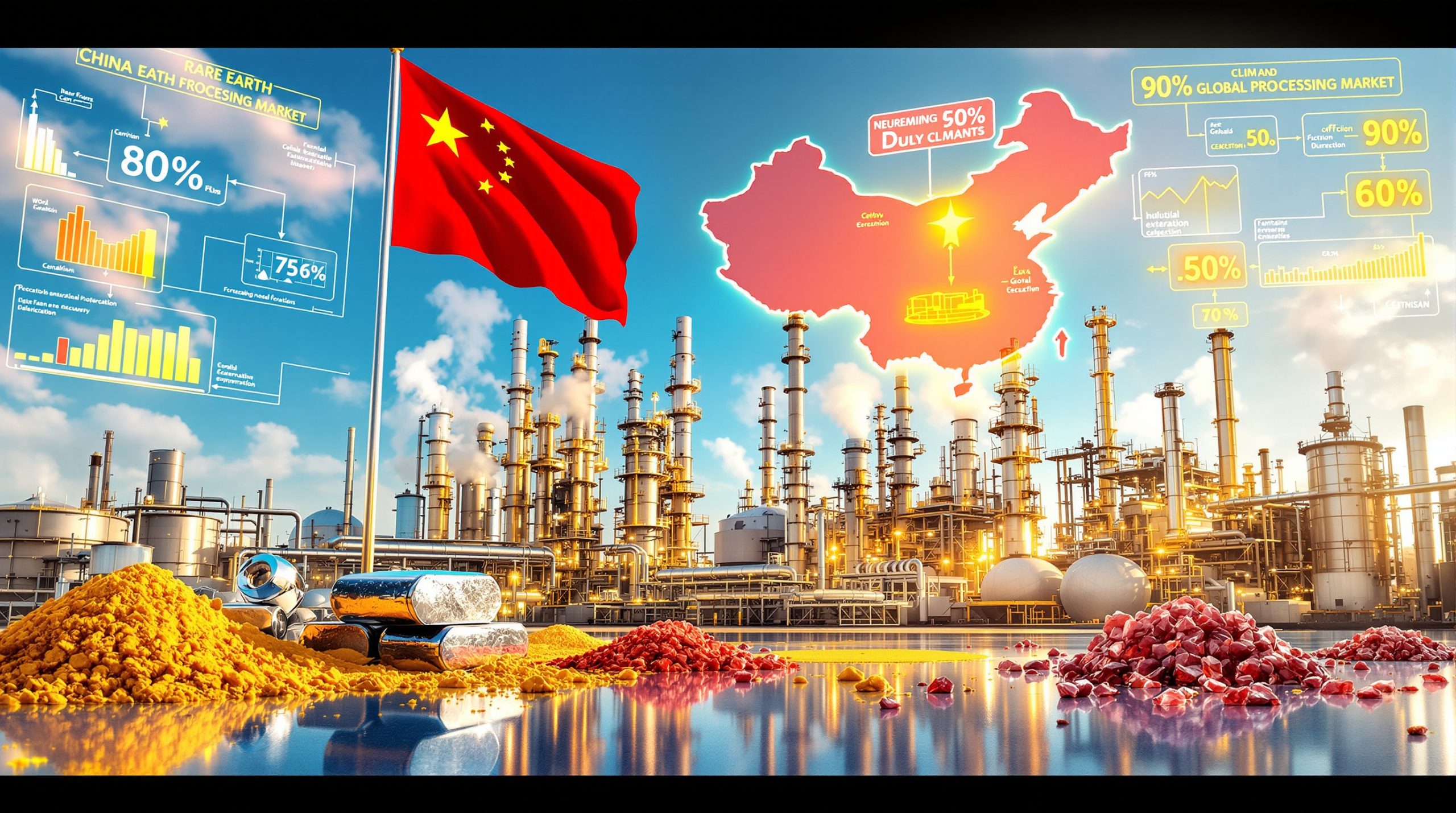Understanding Strategic Mineral Security in 2025
The global race for critical minerals has intensified dramatically, with nations recognising that access to lithium, cobalt, rare earths, and copper directly impacts economic competitiveness and national defence capabilities. Against this backdrop, innovative financing mechanisms are emerging to bridge massive investment gaps in mineral development, particularly as countries establish a critical minerals strategic reserve.
The Orion Critical Mineral Consortium represents a paradigm shift in how Western nations approach mineral security, combining unprecedented scale with strategic government backing. This $1.8 billion initiative, announced on October 24, 2025, demonstrates the urgent priority placed on securing alternative supply chains for materials essential to modern technology and defence systems.
The consortium's establishment comes at a critical juncture. Current global production remains heavily concentrated in geopolitically sensitive regions, with China controlling approximately 60% of rare earth processing and 70% of lithium battery production capacity. This concentration creates vulnerabilities that the Orion Critical Mineral Consortium aims to address through diversified investment strategies.
How Does the Orion Critical Mineral Consortium Address Supply Chain Vulnerabilities?
The Strategic Partnership Framework
The consortium's structure represents an innovative model combining public sector risk mitigation with private capital efficiency. The partnership brings together three key pillars:
- US International Development Finance Corporation (DFC): Provides government backing and de-risking mechanisms
- Orion Resource Partners: Contributes private capital expertise and operational management
- ADQ (Abu Dhabi): Offers sovereign wealth fund stability and Middle Eastern strategic positioning
This tri-partite structure allows the consortium to leverage each partner's comparative advantages. The DFC's involvement, according to CEO Ben Black, addresses what he describes as a paramount matter of US strategic interest and economic prosperity. The corporation's role extends beyond capital provision to include political risk insurance and policy coordination.
The inclusion of ADQ, Abu Dhabi's sovereign wealth fund, reflects broader Middle Eastern strategic diversification away from hydrocarbon dependence. This partnership builds upon the January 30, 2025 establishment of Orion Abu Dhabi, a joint venture that demonstrated the viability of cross-regional critical mineral investment cooperation.
Investment Focus and Methodology
Unlike traditional mining investments that often target greenfield exploration projects, the Orion Critical Mineral Consortium emphasises near-production and existing operations. This approach reflects lessons learned from decades of mining project delays and cost overruns that plague early-stage developments.
Target minerals include:
- Lithium: Essential for battery technology and energy storage systems
- Copper: Critical for electrical infrastructure and renewable energy transmission
- Cobalt: Required for high-performance battery cathodes and aerospace applications
- Rare earth elements: Fundamental to electronics, defence systems, and clean energy technologies
- Defence-critical materials: Specialised alloys and minerals with national security applications
The consortium's geographic diversification strategy focuses on emerging jurisdictions outside traditional supply chains. This approach aims to reduce dependency on established producers while creating new partnerships with resource-rich developing nations seeking foreign investment and technology transfer.
What Makes This $1.8 Billion Investment Unique in Critical Minerals?
Scale and Structure Analysis
The consortium's financial architecture demonstrates unprecedented coordination between public and private capital sources:
| Investment Component | Initial Commitment | Target Expansion |
|---|---|---|
| Total Initial Fund | $1.8 billion | $5 billion |
| US DFC Contribution | Government backing | Policy coordination |
| Orion Resource Partners | Private capital match | Operational expertise |
| ADQ (Abu Dhabi) | Sovereign wealth match | Regional stability |
The structure enables rapid capital deployment while maintaining rigorous due diligence standards. Oskar Lewnowski, founder and CEO of Orion Resource Partners, emphasises that the consortium represents a significant step forward in bridging the substantial funding gap needed to accelerate critical mineral supply chain investment.
Differentiation from Traditional Mining Investment
Several factors distinguish the Orion Critical Mineral Consortium from conventional mining finance models:
Operational Asset Focus: Rather than speculative exploration ventures, the consortium targets assets with established resources, existing infrastructure, or near-term production capability. This approach reduces technical risk and accelerates time-to-market for critical materials.
Government Risk Mitigation: The DFC's participation provides political risk insurance and diplomatic support that private investors typically cannot access independently. This backing proves particularly valuable in emerging market jurisdictions where regulatory frameworks may be evolving.
Integrated Value Chain Approach: The consortium plans to manage offtake agreements and integrate scalable mineral technological solutions, creating vertical integration opportunities that enhance project economics and supply chain security.
Which Critical Minerals Will Benefit Most from This Consortium?
Priority Mineral Categories
The consortium's investment thesis centres on materials experiencing the most severe supply-demand imbalances and geopolitical concentration risks:
Battery Metals represent the largest opportunity set. Global lithium demand is projected to increase 400% by 2030 to support electric vehicle adoption and grid-scale energy storage deployment. Current production capacity remains concentrated in Australia, Chile, and China, creating supply vulnerability for Western manufacturers. Furthermore, the development of a battery-grade lithium refinery demonstrates the growing focus on downstream processing capabilities.
Technology Metals, particularly rare earth elements, face even more acute concentration risks. China controls approximately 85% of global rare earth processing capacity, despite holding only 37% of global reserves. The consortium's focus on alternative processing capabilities could significantly impact this strategic vulnerability.
Infrastructure Metals, especially copper, face mounting supply constraints as global electrification accelerates. The International Copper Association projects a 30% supply deficit by 2030 if current production trends continue. New mine development typically requires 10-15 years from discovery to production, making near-term assets particularly valuable.
Strategic Alloys for defence applications represent smaller volume but higher value opportunities. Materials such as tungsten, titanium, and specialised steel alloys are essential for aerospace, defence, and advanced manufacturing applications where supply security takes precedence over cost considerations.
Supply Chain Impact Assessment
The consortium's investment approach could reshape global mineral supply chains through several mechanisms:
- Alternative Processing Capacity: Developing mineral processing facilities outside China-controlled supply chains
- Strategic Stockpiling: Creating buffer inventories to mitigate supply disruption risks
- Technology Transfer: Implementing advanced extraction and processing technologies in emerging markets
- Long-term Offtake Agreements: Securing predictable supply for Western manufacturers and defence contractors
Timeline projections suggest the consortium's investments could reach material market impact within 3-5 years, significantly faster than traditional greenfield mining development cycles. This aligns with broader initiatives including the establishment of a European CRM facility to strengthen regional supply chains.
How Will This Initiative Reshape Global Critical Mineral Markets?
Geopolitical Implications
The Orion Critical Mineral Consortium represents more than an investment vehicle; it embodies a strategic response to resource nationalism and supply chain weaponisation. The initiative's structure suggests coordination with broader US foreign policy objectives, particularly regarding strategic competition with China. In addition, recent developments such as the critical minerals executive order highlight the political priority attached to mineral security.
The consortium's focus on emerging market jurisdictions could create new geopolitical alignments. Nations with significant mineral resources but limited processing capabilities may find attractive partnership opportunities that provide technology transfer, infrastructure development, and market access.
However, this approach also risks triggering retaliatory responses from established producers. Resource nationalism trends have accelerated globally, with governments increasingly viewing mineral resources as strategic assets requiring state oversight or control.
Market Competition and Pricing Effects
The consortium's scale and strategic backing could influence mineral pricing dynamics through several channels:
Supply Security Premium: Western buyers may pay premium prices for minerals sourced through diversified, politically stable supply chains. This premium could justify higher cost production in emerging markets that might otherwise be uneconomical.
Investment Competition: The consortium's capital base and government backing may intensify competition for attractive mineral assets, potentially driving up acquisition costs and development timelines.
Processing Capacity: Investment in alternative processing facilities could reduce China's pricing power in downstream mineral products, potentially lowering input costs for Western manufacturers over the medium term.
What Are the Investment Criteria and Selection Process?
Asset Evaluation Framework
The consortium's investment approach emphasises rigorous due diligence across multiple dimensions:
Technical Assessment focuses on resource quality, extraction methods, and processing requirements. The consortium prioritises assets with proven reserves, established metallurgical processes, and existing infrastructure to minimise technical execution risk.
Geographic Risk Analysis evaluates political stability, regulatory frameworks, and infrastructure availability. The consortium seeks jurisdictions with transparent legal systems, stable governments, and adequate transportation networks to support mineral export operations.
Environmental, Social, and Governance (ESG) Compliance has become increasingly critical for attracting institutional investment and maintaining operational licences. The consortium emphasises sustainable mining practices, community engagement, and environmental stewardship as core investment criteria.
Strategic Value Assessment considers each asset's contribution to supply chain diversification, defence security, and economic competitiveness objectives beyond pure financial returns.
Timeline and Deployment Strategy
The consortium's aggressive deployment timeline reflects urgent supply security concerns:
Phase 1 (2025-2026): Initial asset acquisition and due diligence completion
Phase 2 (2027-2028): Production ramp-up and processing capacity development
Phase 3 (2029-2030): Scale expansion and additional market entry
This timeline compresses traditional mining investment cycles through focus on near-production assets and government support for regulatory approval processes.
Who Are the Key Players Behind This Consortium?
Orion Resource Partners Profile
Orion Resource Partners brings significant industry expertise and capital markets experience to the consortium. The firm manages approximately $8 billion in metals and materials assets under management, providing operational knowledge essential for successful mineral development.
Oskar Lewnowski, the firm's founder and CEO, has established relationships across global mining markets and proven ability to structure complex international investments. The firm's track record includes both private and public market mineral investments across diverse geographic regions and commodity types.
The firm's previous partnership establishment with ADQ in January 2025 demonstrated successful cross-regional cooperation and laid groundwork for the expanded consortium structure.
Institutional Partner Analysis
US Development Finance Corporation (DFC) serves as the consortium's government anchor, providing political risk mitigation and policy coordination. Founded in 2019, the DFC represents the US government's primary international investment vehicle, with authorisation to deploy up to $60 billion in development finance globally.
ADQ (Abu Dhabi Development and Investment Authority) contributes sovereign wealth fund stability and Middle Eastern strategic positioning. With assets under management exceeding $110 billion, ADQ's participation reflects broader UAE diversification strategies and desire to secure long-term resource access for domestic industrial development.
The consortium structure allows for additional mission-aligned investors to participate, potentially including other sovereign wealth funds, pension funds, and strategic corporate investors seeking supply chain security.
What Challenges Could Impact Consortium Success?
Operational Risk Factors
Political Instability in target jurisdictions represents the most significant risk factor. Emerging markets often experience regulatory changes, policy reversals, and governance challenges that can impact mining operations and investment returns.
Infrastructure Development Requirements in remote mining locations can significantly increase capital costs and development timelines. Many mineral-rich regions lack adequate transportation, power, and water infrastructure necessary for large-scale mining operations.
Technical Execution Risks persist despite focus on near-production assets. Metallurgical challenges, resource grade variations, and processing difficulties can impact production timelines and economics.
Regulatory Approval Processes remain complex and time-consuming even with government backing. Environmental permitting, community consultations, and local content requirements can create significant delays.
Market and Financial Risks
Commodity Price Volatility affects project economics and investment returns. While strategic premiums may provide some protection, fundamental supply-demand dynamics continue to drive mineral pricing.
Currency Fluctuation Impacts can significantly affect international mining investments. Operations in emerging markets face exposure to local currency devaluation and foreign exchange hedging costs.
ESG Compliance Costs continue to escalate as environmental and social standards evolve. Mining operations face increasing scrutiny regarding water usage, emissions, and community impacts.
Competition from Established Producers may respond to new market entrants through capacity expansion, pricing strategies, or vertical integration initiatives that could impact consortium projects.
How Does This Compare to Other Critical Mineral Initiatives?
Government-Backed Programs Comparison
The Orion Critical Mineral Consortium operates within a broader landscape of government-supported mineral security initiatives:
| Initiative | Scale | Focus | Timeline |
|---|---|---|---|
| Orion CMC | $1.8B-$5B | Operational assets | 2025-2030 |
| US Critical Materials Institute | $120M annually | R&D and recycling | Ongoing |
| EU Critical Raw Materials Act | €43B target | Domestic processing | 2024-2030 |
| Canada Critical Minerals Strategy | CAD $3.8B | Full value chain | 2022-2027 |
The consortium's scale and operational focus distinguish it from research-oriented programmes and domestic processing initiatives. Its emphasis on international partnerships and emerging market development creates unique strategic positioning.
Private Sector Investment Landscape
Traditional mining finance has struggled to address critical mineral investment gaps due to long development timelines, technical risks, and geopolitical uncertainties. The consortium's government backing and sovereign wealth fund participation create new investment models that could be replicated across other strategic sectors.
ESG-focused investment funds have increasingly targeted mineral development projects, but often lack scale and government support necessary for rapid deployment. The consortium's structure addresses these limitations while maintaining sustainable development standards.
Technology sector investments in mineral processing and recycling technologies complement the consortium's asset-focused approach, creating opportunities for integrated value chain development. For instance, countries like India are securing lithium supply through innovative partnerships that the consortium could potentially leverage.
What Are the Long-term Implications for Global Supply Chains?
Strategic Outcomes for Western Economies
The consortium's success could fundamentally reshape global mineral supply chains and strategic resource access:
Enhanced Supply Chain Resilience through geographic diversification and alternative processing capacity reduces vulnerability to supply disruptions and price manipulation by concentrated producers.
Accelerated Clean Energy Transition becomes more feasible with secure access to battery metals and renewable energy materials. Current supply constraints represent significant barriers to achieving climate objectives and energy security goals.
Defence Sector Security improves through reliable access to strategic materials essential for advanced weapons systems, aircraft, and critical infrastructure protection.
Economic Competitiveness in advanced manufacturing and technology sectors depends increasingly on secure access to high-quality mineral inputs at competitive prices.
Impact on Emerging Market Development
The consortium's investment approach could create significant economic development opportunities in mineral-rich developing nations:
Technology Transfer through partnerships with international mining companies and processing facilities upgrades local technical capabilities and creates high-skilled employment opportunities.
Infrastructure Development associated with mining projects often provides broader economic benefits including transportation networks, power generation, and telecommunications systems.
Sustainable Mining Practices implementation through ESG compliance requirements can establish new industry standards and environmental protection frameworks.
Capacity Building in regulatory oversight, environmental monitoring, and community engagement strengthens governance institutions and development capabilities.
Frequently Asked Questions About the Orion Critical Mineral Consortium
Investment and Operations
How quickly will investments begin flowing to projects? The consortium aims to deploy initial capital within 6-12 months of establishment, focusing on assets requiring minimal additional development before production commencement.
What percentage of investments will focus on each mineral category? While specific allocations remain confidential, industry analysis suggests 40-50% targeting battery metals, 25-30% on rare earths and technology metals, and 20-25% on infrastructure and defence materials.
How does the consortium plan to manage environmental and social impacts? All investments must meet international ESG standards, including environmental impact assessments, community engagement protocols, and sustainable development frameworks aligned with UN Sustainable Development Goals.
Strategic and Market Questions
Will this initiative affect global mineral pricing? The consortium's scale suggests potential influence on long-term pricing stability and supply security premiums, though short-term price impacts will depend on deployment speed and production ramp-up timelines.
How does this align with existing US trade and foreign policy? The initiative supports broader strategic objectives including supply chain resilience, allied nation partnerships, and economic competition with state-backed Chinese mineral investments.
What opportunities exist for additional investor participation? The consortium structure accommodates mission-aligned institutional investors, sovereign wealth funds, and strategic corporate participants seeking supply chain security and strategic mineral access.
A New Era in Critical Mineral Security
The Orion Critical Mineral Consortium represents a paradigm shift in how Western nations approach mineral security, combining government backing with private sector efficiency and sovereign wealth fund scale. By focusing on near-term production assets rather than speculative exploration, this initiative could significantly accelerate the development of alternative supply chains essential for economic competitiveness and national security.
The consortium's $1.8 billion initial commitment, with expansion potential to $5 billion, demonstrates the scale of investment required to address critical mineral supply gaps. More importantly, its innovative structure combining US government backing, private capital expertise, and Middle Eastern sovereign wealth resources creates a replicable model for international resource development cooperation.
Success metrics will extend beyond financial returns to include supply chain diversification, strategic material security, and sustainable development in emerging market partners. The consortium's emphasis on operational assets and rapid deployment timelines addresses urgent supply security concerns while creating long-term competitive advantages for participating nations.
The consortium's success will likely influence similar initiatives globally, potentially reshaping the geopolitical landscape of critical mineral control and establishing new models for international resource development cooperation. As global competition for strategic materials intensifies, the Orion consortium positions itself at the forefront of a fundamental transformation in how nations secure access to the materials that power modern economies and defence capabilities.
Disclaimer: This analysis is based on publicly available information and industry research. Investment decisions should not be made solely based on this content. Critical mineral markets involve significant risks including commodity price volatility, geopolitical instability, and regulatory changes. Prospective investors should conduct independent due diligence and consult with qualified financial advisors before making investment decisions.
Ready to Identify the Next Critical Mineral Discovery?
Discovery Alert's proprietary Discovery IQ model delivers real-time alerts on significant ASX mineral discoveries, instantly empowering subscribers to identify actionable opportunities ahead of the broader market. Understand why historic discoveries can generate substantial returns by exploring major mineral finds that transformed small-cap companies into market leaders.




